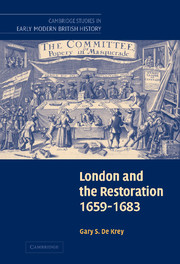Book contents
- Frontmatter
- Contents
- List of figures
- Map
- List of tables
- Preface
- List of abbreviations
- Part I Crisis, 1659–1660
- Introduction to Parts I and II: London and the nation
- 1 London and the origins of the Restoration, 1659–1660
- Part II Settlement and unsettlement, 1660–1679
- Part III Crisis, 1679–1682
- Part IV Crisis and conspiracy, 1682–1683
- Conclusion: London and the end of the Restoration
- Appendices
- Appendix I 1670 London dissenting subscription
- Appendix II London dissenting common councilmen, 1669–1671
- Appendix III Whig party leaders
- Appendix IV Tory party leaders
- Bibliography
- Index
- Titles in the series
1 - London and the origins of the Restoration, 1659–1660
Published online by Cambridge University Press: 07 May 2010
- Frontmatter
- Contents
- List of figures
- Map
- List of tables
- Preface
- List of abbreviations
- Part I Crisis, 1659–1660
- Introduction to Parts I and II: London and the nation
- 1 London and the origins of the Restoration, 1659–1660
- Part II Settlement and unsettlement, 1660–1679
- Part III Crisis, 1679–1682
- Part IV Crisis and conspiracy, 1682–1683
- Conclusion: London and the end of the Restoration
- Appendices
- Appendix I 1670 London dissenting subscription
- Appendix II London dissenting common councilmen, 1669–1671
- Appendix III Whig party leaders
- Appendix IV Tory party leaders
- Bibliography
- Index
- Titles in the series
Summary
THE ALIENATION OF THE CITY
The disposal of Richard Cromwell and his parliament by the leaders of the New Model Army in April 1659 was the most significant turning-point in the English Revolution since 1649. As Protector, Richard had been supported in parliament and in the localities by broad and somewhat ambiguous coalitions of pragmatists, Presbyterians, and “royalists.” He had been the hope of all those who saw in the Cromwellian church and in the last Protectorate parliament the best prospects for stable government and an enduring parochial establishment. But now the entire post-1653 Cromwellian endeavor to achieve political and religious reconciliation had been destroyed. The nation's affairs had fallen again into the hands of those who had purged the Long Parliament in 1648, who had abrogated the Solemn League and Covenant, who had killed the last king, and who had ever since (in the minds of their critics) threatened national ministry.
The hostility of most London citizens and their leaders to the revived republican regime would prevent a successful resettlement of the nation and instead contribute to a rapidly enlarging national crisis. The Commonwealth's inability to control its capital was at the heart of its failure. The opposition movement that developed in the Corporation of London and that inspired opposition elsewhere sprang from an unexpected and ambiguous convergence of two broad groups dedicated to the pre-1649 constitution in church and state, Reformed Protestants and Anglican loyalists.
- Type
- Chapter
- Information
- London and the Restoration, 1659–1683 , pp. 19 - 66Publisher: Cambridge University PressPrint publication year: 2005
- 1
- Cited by



